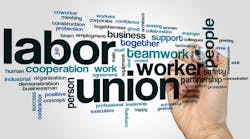President Biden promised to be the most pro-union president in American history and, according to a recent Gallup poll, the number of Americans who view labor unions favorably is at 71%, the highest approval rating the country has seen since 1965. Also, the National Labor Relations Board (NLRB) reported that for the first nine months of Fiscal Year 2022 (October 1, 2021 – June 30, 2022), labor unions filed 58% more representation petitions than they did during the same period a year earlier.
In the last few years, unions have won campaigns at several national companies with well-recognized brands, such as Apple, Google, and Amazon. Data and information released on January 19, 2023, by the Bureau of Labor Statistics (BLS) confirms that labor unions are gaining momentum. According to the BLS report, the total number of private sector employees in the United States who are members of a union increased by 2.75% in 2022—the largest increase since 2013. Further, the total number of manufacturing employees who are union members increased by 5.27% in 2022, which is also the largest increase since 2013. Significantly, while the overall percentage of private sector employees who are represented by a union decreased in 2022, the percentage of private sector manufacturing employees who are represented by a union increased.
Manufacturers may therefore be wondering: Why do employees unionize? Are there signs that employees are planning to organize? What steps can an employer take? We address these questions below to help manufacturers prepare for potential unionization of their workforce.
Why do employees unionize?
Employees look to labor unions for a variety of reasons; Although it’s impossible to say what specific issues will drive a particular workforce towards a union, most often, a few key issues drive unionization efforts; In some cases, employees mistakenly believe that a union will “automatically” bring higher pay and better benefits. Employees may also feel frustrated with their working conditions, such as those related to health and safety, hours, schedules, and assignments. Another prevalent concern that drives unionization is respect and dignity. Do employees feel disrespected at work or is a supervisor or manager perceived as an ogre who doesn’t consider the impact of a decision on employees?
In these cases, employees may turn to a union as a means for “having a voice” on this range of issues and workplace concerns. Ultimately, unions are a representative, i.e., a vehicle for communication, that help employees feels as though they have a voice and can provide input on important decisions.
Are there signs that employees are planning to organize?
Yes, often times a number of signs can signal that employees are considering or planning to unionize. These signs include, but are not limited to, an increase in questions about policies and practices, the adoption of a new or common vocabulary (i.e., using words like “a voice at the table,” “concerted,” or “recognition”), new informal leaders emerging among employees, and new groupings or friendships among employees. Generally, if supervisors or managers observe behavior that is out of the ordinary for their workforce, employers should be on notice that unionization is a possibility.
What steps can an employer take?
;Manufacturers can take proactive steps related to their policies and practices to help address issues within the workforce that could lead to unionization. Fostering a positive work culture that encourages communication and treats all employees with dignity and respect can have a huge effect on employee relations. For example, employers should consider ensuring that supervisors and managers are visible and accessible; providing consistent, open, and frequent communication; and establishing a user-friendly complaint process to listen to employees and effectively address complaints.
Additionally, manufacturers may want to ensure they have the right policies in place and that those policies are up-to-date and legally compliant. Manufacturers may want to pay particular attention to solicitation/distribution, open door, confidentiality, and social media policies to confirm that they do not infringe on employee’s protected rights under federal labor laws. Manufacturers may also wish to audit their pay practices to understand and remedy potential pay disparities and inequities and to ensure that employees are fairly compensated based on their total compensation packages. Manufacturers may find that enhancing lines of communication and informing employees about benefits currently offered as well as any steps they are taking with respect to increasing pay and improving work conditions will strengthen the employer-employee relationship.; Finally, because a union is (in a very basic sense), a means of communication, manufacturers may wish to consider expanding avenues for employee input and direct communication.
Manufacturers may also consider communicating with employees directly about unions and the choice to unionize, but, in electing to do so, should proceed cautiously. The National Labor Relations Act (NLRA) protects employees’ rights to express their views about unions, and certain employer statements about unionization are unlawful, such as threats if unionization occurs or the promise of a benefit to avoid unionization. Therefore, manufacturers should be careful not to engage in certain activities that may be perceived as restricting employees’ rights under the NLRA. Manufacturers may want to consider training supervisors and managers about how to properly communicate with employees regarding potential or actual union activity to avoid common pitfalls.
Takeaway
Unionization is a real possibility for all manufacturers and can have a large effect on a business’s operations. Manufacturers can take some important steps now that may not be available once a union organizing drive begins. Manufacturers may want to identify risks, priorities, and action items as it relates to unionization within their workforce. Understanding why employees unionize and what steps employers can take to enhance employee relations will help employers appropriately and lawfully navigate union-related issues. Irrespective of the rise in organizing, manufacturers may wish to create and develop measures to foster an environment that promotes open and effective communication with their employees. Manufacturers may wish to speak with competent legal counsel regarding best practices for strengthening communication, revising policies and practices, and training personnel to address workplace needs.
Natale V. DiNatale is chair of Robinson+Cole’s Labor Relations Group. He counsels employers on all facets of employment law and has devoted his practice almost exclusively to management-side labor relations in the private sector.
A member of Robinson+Cole’s Robinson+Cole’s Labor Relations Group Kayla N. West focuses her practice on representing private sector employers in labor and employment matters as well as defending employers in federal and state court and before administrative agencies.
About the Author

Natale V. DiNatale
Chair, Labor Relations Group, Robinson+Cole
Natale DiNatale is a member of the firm’s Labor, Employment, Benefits + Immigration Group and is the chair of the firm’s Labor Relations Group, which is both nationally and regionally ranked in U.S. News – Best Lawyers "Best Law Firms" in the area of Labor Law - Management. He counsels employers on all facets of employment law and has devoted his practice almost exclusively to management-side labor relations in the private sector. He has worked with employers in numerous industries, including health care (acute care hospitals, skilled nursing facilities, assisted living facilities, and home care service providers), manufacturing, higher education, data, cultural, arts, utility, and building services.
Natale was ranked in Chambers USA: America's Leading Lawyers for Business in the State of Connecticut in the area of Labor & Employment in 2020. He has been listed in The Best Lawyers in America© in the area of Employment Law - Management since 2014 and in the area of Labor Law - Management for 2021.
